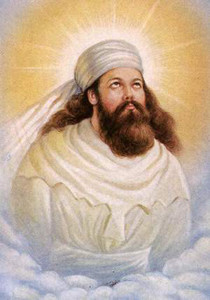Paul Derengowski, ThM
Founder & Origin
 The founder of Zoroastrianism is none other than Zoroaster or Zarathushtra. When Zoroaster lived is unclear, and that because he lived during prehistoric times.[ref]Mary Boyce, Zoroastrianism (New York: Routledge, reprint 2007), 18.[/ref] Some conflicting accounts have him living as early as 6000 B.C., but more at more plausible time period has him living anywhere from between 1700-1200 B.C. We do know that Zoroaster lived in modern-day Iran, or ancient Persia, and served as a Brahmin priest. As was consistent of other spiritual leaders of his day, he spent considerable time wandering the Iranian countryside attempting to discover the truth. At the age of 30 he made the discovery, and is confronted with a supernatural visitation where he is led into the presence of a divine heptad, and would later declare that Ahura Mazda was the only true, Creator God of all that is.
The founder of Zoroastrianism is none other than Zoroaster or Zarathushtra. When Zoroaster lived is unclear, and that because he lived during prehistoric times.[ref]Mary Boyce, Zoroastrianism (New York: Routledge, reprint 2007), 18.[/ref] Some conflicting accounts have him living as early as 6000 B.C., but more at more plausible time period has him living anywhere from between 1700-1200 B.C. We do know that Zoroaster lived in modern-day Iran, or ancient Persia, and served as a Brahmin priest. As was consistent of other spiritual leaders of his day, he spent considerable time wandering the Iranian countryside attempting to discover the truth. At the age of 30 he made the discovery, and is confronted with a supernatural visitation where he is led into the presence of a divine heptad, and would later declare that Ahura Mazda was the only true, Creator God of all that is.
Distinct Beliefs
- There is one God, and its name is Ahura Mazda or “Wise Lord.” His “twin” and equal adversary is Druj (Drug), or the spirit of the Lie.
- Ahura Mazda created six “Beneficent Immortals” called the Amesha Spentas. They are those who reflect Ahura Mazda’s character and actions, and “are in the fact the beneficent gods of the pagan Iranian pantheon.”[ref]Ibid., 21.[/ref] Combined, the Amesha Spentas represent different aspects of the created earth: fire, cattle, metal, earth itself, water, and plants.
- Zoroastrianism teaches that a cosmic dualism exists between Ahura Mazda, through Spenta Mainyu (the “Holy Spirit”) and another spirit named Anghra Mainyu, or the “Destructive Spirit.”
- Human beings are the product of the creative ability of Ahura Mazda, and have been endowed with free agency to be able to choose between good and evil.
- Sin is the result of rebelling against asha, which is viewed as a principle which guides the world. Some have suggested that sin could also consist of a the dualistic battle that is ongoing between good and evil in the human heart.
- Salvation is contingent upon human works. “Good” people eventually accept the “true religion” of Zoroaster, and “bad” people do not.
- After death the human soul (fravashis)[ref]Fravashis are also seen as guardian genius who protect both humans and the gods.[/ref] goes to either heaven or hell, which entails a weighing in the balance of good versus bad works during one’s lifetime. The final judgment takes place at the Chinvat Bridge (more like a blade), where depending on one’s works one will either be escorted across the bridge to paradise by a beautiful maiden, or be seized by an ugly hag and fall off the bridge, as it turns blade-up, and one descends into the abyss.
- A millennium and resurrection are anticipated in the next life, with Ahura Mazda finally conquering Angra Mainyu.
Holy Books
The main text of Zoroastrianism is the Avesta. It consists of 21 divisions, with the primary writings being the Yasna and the Gathas. The Yasna is a liturgical book dealing with law, liturgy, and doctrinal belief. The Gathas are mainly poetic in nature and contain the most information about the person of Zoroaster, even though of the 100,000 or so strophes that make up the Gathas are no longer extant.
Worship
Aside from recognition of Ahura Mazda as the Supreme deity, Zoroastrians recognize the purity of fire in their rituals, especially since a continuous blaze is kept burning in their temples. In fact, it is not uncommon for Zoroastrians to set apart a special room in the temple just for the attendance of the eternal flame, which is a 24/7 process using rotating priest that has been going on for thousands of years. Also unique to the process the Zoroastrian priest wears a white cloth to cover his mouth so as to prevent contaminating the flame with his breath. According to Zaehner, “Thus is it to the Good Mind that Zoroaster confesses himself to be a genuine follower of Truth, and again it is through him that he establishes the fire as the centre of his cult.”[ref] R. C. Zaehner, The Dawn and Twilight of Zoroastrianism (New York: Phoenix, 1961), 49.[/ref]
Another aspect of worship that is distinctive of Zoroastrianism is the extraction of Haoma juice ritual. Haoma juice is produced from the pressing of the Ephedra plant, which is thought to “exhilarate men and heighten their powers. Warriors drinking it would quickly be filled with battle-fury, poets be inspired, and priests become more open to divine promptings.”[ref] Boyce, 5.[/ref] According to the National Institute of Health, “Ephedra is an evergreen shrub-like plant native to Central Asia and Mongolia. The principal active ingredient, ephedrine, is a compound that can powerfully stimulate the nervous system and heart.[ref]http://nccam.nih.gov/health/ephedra/ataglance.htm.[/ref] During the ritual (which would last from dawn until sunset) the priest would perform the animal sacrifice and then drink the Haoma juice either mixed with water or milk along with the worshippers, after it had been first offered to the fire, which was seen as a symbol representation of Ahura Mazda. The purpose of Haoma ritual (also known as the Yasna) was “to procure immortality both of body and soul, bodily immortality deriving from the bull and that of the soul from the Haoma.”[ref]Zaehner, 90.[/ref]
The Afterlife
Zoroastrianism teaches there is both a heaven and a hell that all persons will eventually go upon dying. Salvation unto heaven is merited through one’s personal effort, which is judged by Mithra at the Chinvat Bridge. At the bridge, which spans the abyss of hell, the deceased stands on one side, with paradise and Mithra on the other end of the bridge judging his works? If one’s works are deemed to contain more good than bad, then the bridge, which appears as a blade, turns broadways and a beautiful assistant comes to aid the deceased so that he may walk across the blade to paradise. Conversely, if one’s works are deemed to contain more bad than good, then the bridge (blade) turns narrowly upright, and after the deceased begins his walk across the blade an ugly hag meets the deceased and helps to cause the person to fall off the blade into the abyss.
Also distinct among the Zoroastrians is the “Parsis Towers of Silence” or the dakhmas. Early one in order to prevent human corpses from polluted either the soil or the water, the deceased were taken out into the wilderness and left for the scavenger animals and birds to consume the body, and after a time of allowing the bones to bleach in the sun and dry, the priests would return and bury the bones. Later the Zoroastrians began to built Parsis Towers, which accomplished the same ends as leaving a corpse in the wilderness; it just made things a bit more convenient. Again, the priests would carry the deceased body to an isolated location where a tower had been built, offer a few words of liturgy over a partially exposed body, and then leave to allow the vultures to pick the bones clean of any flesh.[ref]One citation in David Noss’ book A History of the World’s Religions quotes James Hope Moulton and his The Treasure of the Magi as saying, “as soon as the corpse-bearers have left the Tower, the vultures swoop down from their post of observation round the wall, and in half an hour there is nothing left but the skeleton. Quickly the bones dry, and the corpse-bearers enter again after some days, and cast the bones into the central well, where they crumble away” (p. 149).[/ref]
Evaluation
It has been said that Zoroastrianism has impacted several of history’s most prominent religions, including Judaism, Christianity, and Islam, usually because of the antiquity and similarity of the beliefs between Zoroastrianism and those religions. But, if the generally accepted date of Zoroaster’s life is true, then he actually came along much later than the nation of Israel, making the antiquity argument tenuous at best. Moreover, given that Judaism preceded Zoroaster, then Judaism would have impacted Zoroastrianism, and not the other way around. And even at that there are so many differences between the two religions that whatever affect Judaism had on Zoroastrianism, one could almost conclude that the affect itself was negligible.
As for the affect upon Christianity, again the differences far outweigh the similarities. Christianity has never been a polytheistic religion, and yet that is what Zoroastrianism is, despite the appeal to Ahura Mazda as the supreme deity. Christianity’s salvific system is not predicated on individual effort to merit enough of a good standing with God to help the Christian across a fictitious bridge spanning hell. And Christians hardly view the body as being so unclean that it is thought best to leave it for the wild beasts and scavenger birds to consume at death, than to bury it with dignity.
If Zoroastrianism did have any impact upon one of the “big three” religions, it might have been Islam, and that in only a limited sense. Islam is extremely monotheistic, yet its system of salvation is based solely in the works-effort of the Muslim. Furthermore, Zoroastrianism advocates a rigid and structured prayer life that is similar to Islam, with observances of prayer by both done five times a day. Yet, once again, there are too many differences between the two religions to conclusively prove that Zoroastrianism had a definitive impact upon Islam.
Zoroastrianism itself is simply an ancient pagan religion that has managed to hold on unto the present. As far as worship value it has evolved from primarily a monotheistic religion into a polytheistic one. Salvifically speaking, if one desires to enter heaven one day one must subjectively do one’s best during this life or risk being dragged into hell while attempting to cross the Chinvat Bridge. No one knows, however, whether or not they have done enough until that day, which from a Christian perspective cannot bring any peace or hopeful expectation. Besides, if one can earn one’s salvation, then who needs a god ruling over them or determining whether or not they are good enough to enter that god’s heaven? Clearly, aside from some of the favorable moral aspects of Zoroastrian life, it, like so many false religions and Christian cults, is not unique enough to align itself with the God of biblical Scripture, and certainly offers nothing distinct enough to prove that the god of Zoroastrianism even cares.

Be the first to comment on "Zoroastrianism: The Religion of Zarathustra"